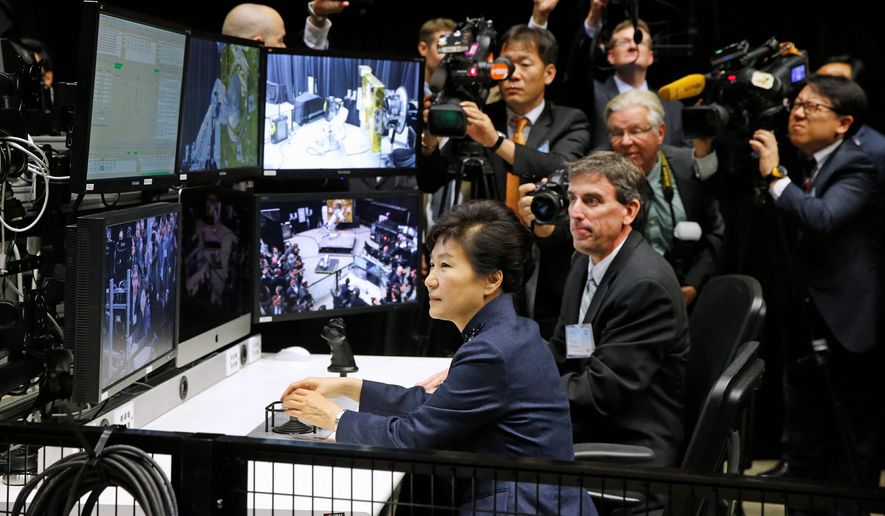The historic visit of Park Geun-hye, president of the Republic of South Korea, to the National Aeronautics and Space Administration (NASA) is not surprising considering her plan to move the country toward a “creative economy.” The words “exploration” and “innovation” could not be excluded from the many words that describe NASA because of its sense of creativeness and daring boldness. NASA is also well known for its spinoff technologies.
Commercial products and services have been developed via cooperation with NASA, including research and development contracts and use of NASA facilities. Technical assistance from NASA personnel and data from NASA research are also invaluable. The Korean economy has reached the limits of the catch-up strategy that has driven economic growth for the last 40 years, so a new growth model based on innovation and entrepreneurship is now being promoted.
The NASA Goddard Space Flight Center (GSFC) plans to highlight a few successful collaborations with the Republic of South Korea for President Park’s visit. Among these, ISS-CREAM (pronounced “ice-cream”) led by a Korean American professor at the University of Maryland (UMD) illustrates how innovative ideas culminate in a space mission.
The balloon-borne Cosmic Ray Energetics and Mass (CREAM) experiment was flown for a record-setting 161 days in six flights over Antarctica. Building on the success of those balloon flights, the payload has recently been converted for exposure on the International Space Station (ISS). Professor Seo was on the cover of The Washington Post magazine last year with a note: “Professor Seo and the Cosmic Rays: Not a band, just out-of-this world research.” An article entitled “UMD-Goddard programs offer students out-of-this-world opportunities” featured ISS-CREAM, the highest energy frontier for direct measurements of cosmic rays.
After completion of qualification and verification tests at NASA GSFC, the ISS-CREAM payload was recently delivered to the Kennedy Space Center (KSC) for integration with the SpaceX launch vehicle. Its launch is scheduled for 2016. It is planned that ISS-CREAM will take data for three or more years on the ISS to solve long-standing mysteries of cosmic rays. This mission is managed by the NASA GSFC Wallops Flight Facility as a pathfinder for low-cost space missions.
The collaboration among NASA, universities and industry has been a fruitful and leading, world-class success story. In the implementation of space missions, there are moments to take risks. What appears to be an impossible challenge can bring opportunities for innovation. Sometimes the bold decisions that have to be made provide excitement and passion that drive dedicated people to come up with new and creative ideas. This is the type of environment where innovation is ignited with inspiration [and] fueled by imagination that results in an idea that can then be put into a process to create change. A sense of mission is the basis for a dedicated team, such as the Korean collaborators, who provided a state-of-the-art detector for particle identification, key to the successful delivery of ISS-CREAM.
President Park’s “creative economy” approach requires interdisciplinary integration and innovation. The greatest asset of the science and engineering sector central to this effort is its incredibly talented population, not only in Korea but in the US.
Needless to say, the Korean-American Scientists and Engineers’ role is critical (KSEA). The KSEA, established in 1971 as a nonprofit professional organization, has grown to over 10,000 registered members with 70 local chapters (including four branches) and 13 technical groups across the United States. Its objectives are to promote application of science and technology for the general welfare of society, to foster international cooperation — especially between the U.S. and Korea — and to help the organization members develop their full career potential.
Its annual U.S.-Korea Conference on Science, Technology, and Entrepreneurship draws more than 1,000 attendees each year. It organizes numerous conferences, seminars and forums, including the Young Generation Technology & Leadership Conference and the Early Career Development Workshop. KSEA also organizes National Mathematics & Science Competitions (NMSC) for 4th to 11th grade students annually to promote science, technology, engineering and math education. Over 2,000 students participate in NMSC each year. In addition, it gives approximately 50 scholarships for undergraduate and graduate students in collaboration with the Korea-U.S. Science Cooperation Center (KUSCO).
More attention on diversity could be helpful. Korean-American Women in Science and Engineering (KWiSE), established in 2004, now has about 1,000 Korean women scientists and engineers in the U.S. as its members. Most members are Ph.D.s in broad disciplines, and a significant faction of talented members are in biomedical area. The timing is ripe for the U.S. and Korea to form an innovation alliance. The success of this “creative economy” approach may depend on how well the Korean-American scientific community serves as a major resource for the creative economy.
• Eun-Suk Seo, Ph.D., is professor of physics at the University of Maryland and vice president of the Korean-American Scientists and Engineers Association.




Please read our comment policy before commenting.